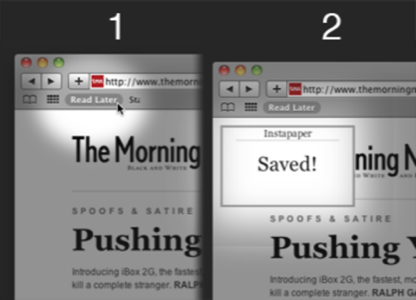A common theme of our product innovation series has been exploring applications that take advantage of new devices – and the user experience patterns that evolve out of that. Instapaper is perfect example of this. It started out as a web application, then embraced smart phones, and now it’s being used by many iPad owners. In a nutshell, Instapaper is an app that saves web pages for reading later. But unlike older ‘web 2.0’ social bookmarking services, it doesn’t just bookmark a web page. Instapaper saves a copy of the content so it can be read later, offline if need be, within the app.

Instapaper was launched in January 2008 by the co-founder of Tumblr, Marco Arment. In fact Arment has only just gone full-time with Instapaper, announcing last month that he’s moving on from Tumblr after 4 years as its lead developer. He has big plans for Instapaper as a business, as you’ll discover in this interview.
Richard MacManus: So you’ve just left Tumblr and you’re working full time on Instapaper now. Are you turning it into a business?
Marco Arment: Yes, that’s correct. It’s more continuing it as a business, because it’s kind of always been one. Just now I have more time to spend on it.

RM: How did you come up with the idea for Instapaper and what was the inspiration for it?
MA: I’d just gotten an iPhone in the fall of ’07. I would find things during the workday that I wanted to read, but I was at work – so I really couldn’t. I would skim articles [or] I would open a tab and never go back to it, until my browser crashed and then I forgot about it. Or some other non-solution to this problem. [chuckle] And then similarly, I had to commute on the train everyday for about an hour or two. When I was on the train, I had my iPhone and I could browse the internet – but only before it went underground. There were a load of things I had to read.
So I made Instapaper just for myself, really, and didn’t even tell anybody about it for about three months after I made it. I just used it myself, just because I wanted something to use to temporarily store those links – so that I could save them at work and read them on the train.
That’s how it started and it was very, very basic. In the beginning, there wasn’t even a text view. And the reason I got the text view was because mobile Safari [on iPhone] would kick pages out of memory if you load it too much. And so what I was trying to do was load a bunch of pages at once, before the train went underground and before I lost my connectivity for about 25 minutes or so. The text view allowed me to store more than in the mobile browser, because they were much lighter.
Also when I would scroll on the iPhone, I hated if I accidentally lost the alignment in the column I was reading. It would accidentally scroll drag me a little bit and I couldn’t scroll it up again. [chuckle] So I made it single-column reading.
“It was popular very quickly, far past my expectations. I wasn’t sure if anybody else would find it useful.”
I told a couple of friends about it, about three months in, and they loved it. So on January 26th, 2008, I made my initial blog post about it and it just exploded! It was popular very quickly, far past my expectations. I wasn’t sure if anybody else would find it useful. [laughter] I figured that I just thought of myself, that it’s useful to me but… I was very pleasantly surprised by its reception.
RM: What was the time period between the time that you came up with the idea and when you launched Instapaper in January 2008?
MA: It was about three months.
RM: So it was a very quick development process…
MA: Yeah. I developed the basics of the service in about two nights. It was a very basic service. And I already had a lot of the framework. I already had a lot of that written for other things, including Tumblr. It was in a language I already knew and a framework I already knew. And so I made the entire first draft of the service, I guess you can call it, in about two nights.
How the iPad Version Was Developed
RM: And when did you come up with the iPad version of Instapaper and the idea of integrating that with iPad apps?
MA: I was already doing all these weird mobile Safari apps, so I jumped right on the opportunity to make a real app as soon as it came. I was in the iPhone store on day one, of course. Sorry, actually on day two or three. [chuckle] I tried to be there on day one but missed it. Anyway, so I was in the iPad store right in summer ’08 when it launched.

So when the iPad was announced and the SDK for it, I knew I needed an iPad app in addition to the iPhone app. I also decided pretty early on that I would make a universal app which would work on both – preferably optimized interfaces for each one – and that was only half done [at the time the iPad was announced]. The question was really whether I wanted to release that in advance of the launch of the iPad, so it would be there on day one. But I would never have a chance to actually try it on an iPad before submitting it, which is certainly a risk. Or I could wait until after I used an iPad physically and optimize it, then submit it afterward.
I chose to go with the option of having it there on day one [i.e. releasing it before the iPad launched] and taking that risk. And it worked out alright. The first version was functional. It was not pretty, but it worked. And yeah, there were some buttons which were badly placed, the colors were way too bright, the screen was much brighter than I thought it would be. So I made a few tweaks and released an update, a couple of weeks later.
RM: I’m finding the Instapaper app very useful on iPad, for example when I’m using Flipboard and I can save articles I find there to read later on. I like the integration with other apps in the App Store as well.
MA: Thanks. That’s been a huge benefit for Instapaper. The first app I ever made was for Tweetie for iPhone. Now, almost every mobile Twitter client and almost every mobile feed reader has a ‘Send to Instapaper’ feature.
RM: What are the main usage patterns that you’ve noticed so far with Instapaper – and has anything surprised you about how people are using it? Whether on the iPhone, or iPad or even on the web.
“At least half of my paid app sales are from the iPad.”
MA: Yeah, there have been few surprises. One of the biggest was when I first launched the iPhone app, I thought that it would just be people who are already familiar with the web app – that they’d want the iPhone app to go along with it. Okay, that’s pretty much the way I use it. I use the web app first and the iPhone app as an accessory to it. And what surprised me was from the very beginning – and it still holds true today – how many people do both the browsing and the reading on the iPhone. Instapaper is really optimized for browsing on the computer and then reading on the iPhone. But a lot of people just do everything on the iPhone.
Another big surprise was that the iPad has taken off like crazy. At least half of my paid app sales are from the iPad, which given the size of its relative installed base (iPad versus the iPhone), that’s a pretty impressive number.

The iPad has proven to be a better device for reading content than even I expected. I had high hopes for it, but I thought it would be about the same for reading as the iPhone. And it ended up that a lot more people find the bigger screen more comfortable. So a lot more people are reading web content on the iPad than on the iPhone.
RM: Yes, that’s certainly been my experience. So is the success of the iPad what prompted you to go full time on the business?
MA: Oh sure, that was a huge part. Especially because the iPad sales [of Instapaper] have more than doubled my overall sales since the iPad came out. So it finally gave me enough momentum to take it full time.
RM: Right. And are you hiring other people in the business?
MA: Not at the moment. I do have a contractor who edits the front page editor’s picks, also called “Give me something to read.” It’s the popular, good, long form stories saved by users. So I have a contractor who does that. But otherwise it’s just me.
In the future I might hire employees to help out with certain things, but I have no immediate plans to do that.
The Future of Instapaper
RM: Let’s discuss the future of the product. Do you plan to expand to other delivery platforms, or are you going to stay focused on iPad and iPhone?
“I’m going to make a full feature API, so that other people can write clients for [Android, Blackberry, etc]”
MA: For now, I’m certainly focusing on the iOS platform and also on the Kindle. I really do like the Kindle a lot. It’s a much smaller market, but it’s a very devoted and very hardcore market – people who really love reading. So right now it’s iOS and Kindle. I don’t have any immediate plans to support Android or Blackberry, or other mobile platforms directly. But what I’m going to do is make a full feature API, so that other people can write clients for those if they want to.
Right now there are a few Android clients that are unofficial, but because there’s no good official API they have just kind of scraped the site to try and make it work. And it’s worked with mixed success. So hopefully a real API will encourage better clients to be made.
RM: Will Instapaper add more social sharing and curation features in the near future? [hat-tip Justin Houk for suggesting this question via Twitter]
MA: That’s a good question. One thing I do want to do is have better export support for services that will help you with long-time archival. Things like Evernote, Delicious and Pinboard. So I definitely want to add those. I wouldn’t really classify any of those, except maybe Delicious, as social though. And Delicious, while it is technically social, I don’t think it’s really used like that as much anymore – if it ever was. So I want to add features that help people with their own organization.
I also want to add features that help people with information overload management. I don’t want Instapaper to just be another bucket for the thousands of items that you have deal with and that you feel obligated and burdened by. That’s the last thing I want. So what I really want to do is give people tools to help them manage information overload [so] that it’s not a burden, that relieves them of stress rather than adding to it.
“I have a few draft ideas in my head [for] sharing features.”
Regarding social features, I have a few draft ideas in my head of some kind of sharing features. For the most part they’re very, very alpha stage. But even in my head there’s something I roughly want to do. It’s the kind of feature that before I was doing this full time, which was only two weeks ago, I would never have had the time to do non-essential features like that. Now that I have time to do that sort of thing, I will probably explore those options in the future.










